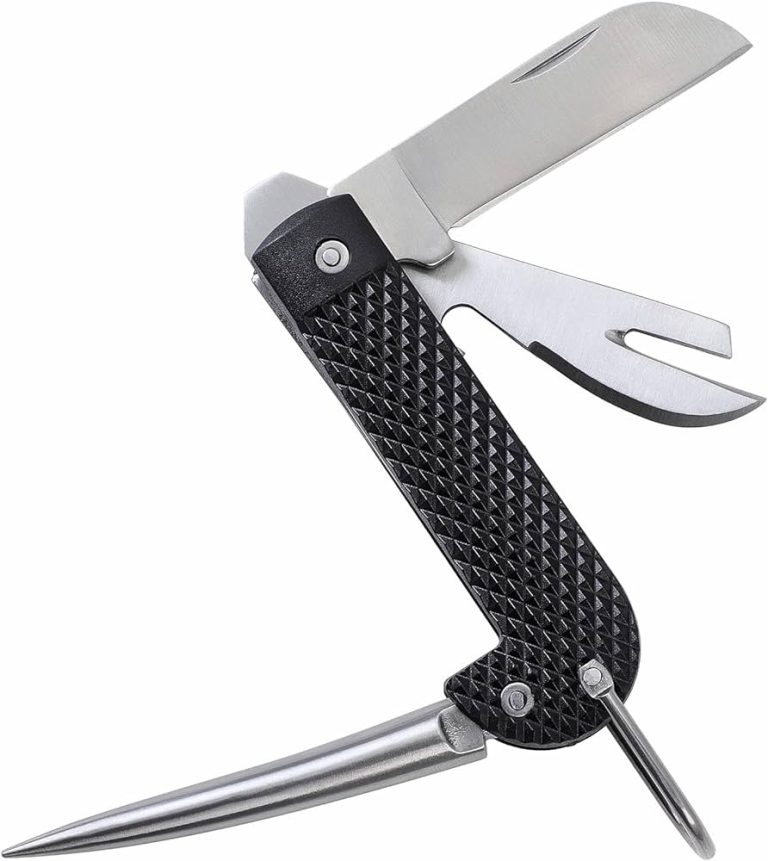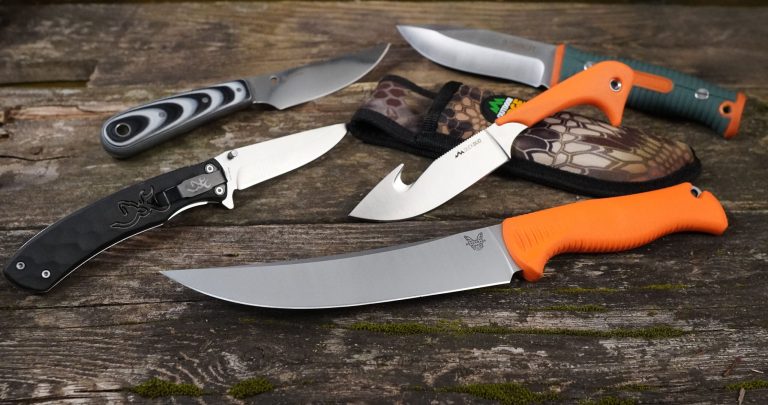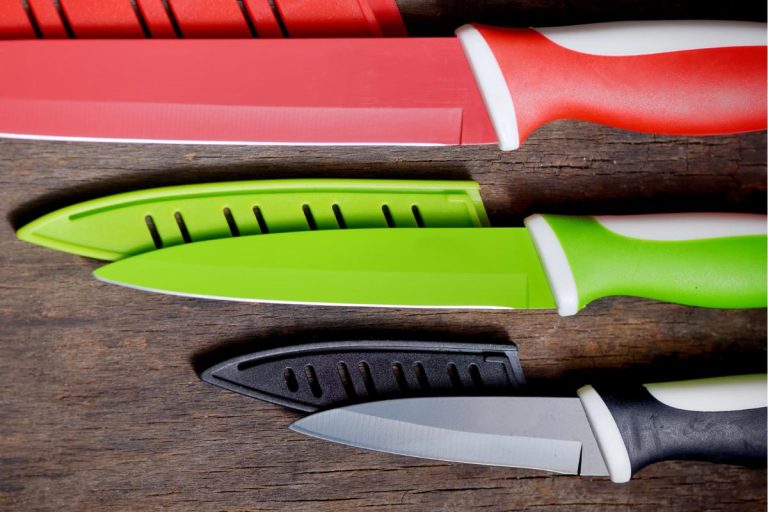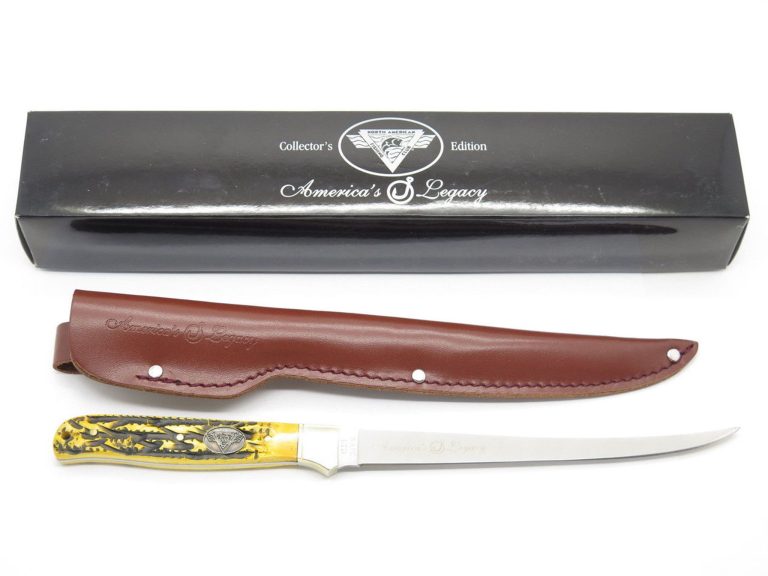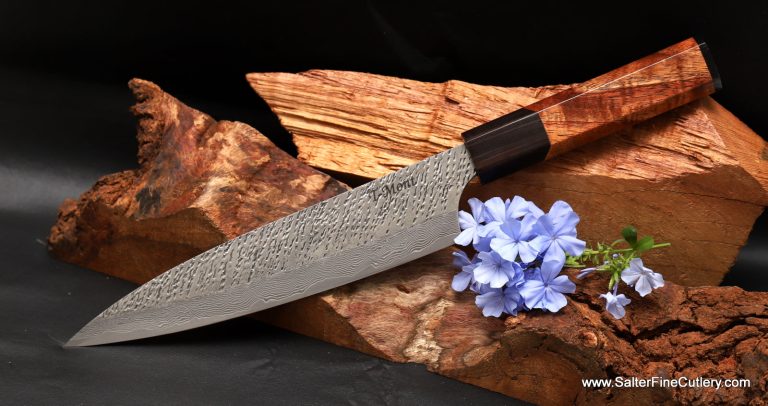How to Choose a Hunting Knife
To choose a hunting knife, consider the blade material, design, size, handle, and durability. Hunting knives should be sharp, sturdy, and suitable for the task at hand.
Are you an avid hunter looking for the perfect hunting knife? A reliable, high-quality knife is an essential tool for any hunting expedition. The right knife can make all the difference in field dressing, skinning, and cutting through various materials.
With a plethora of options available, selecting the ideal hunting knife can be overwhelming. Fear not, as this guide will provide you with valuable insights on how to choose a hunting knife that meets your specific needs and preferences. Whether you’re a beginner or seasoned hunter, finding a knife that strikes the perfect balance between versatility, durability, and functionality is vital. Before diving into the vast sea of hunting knives, keep reading to discover the key factors to consider when selecting the right one.
Hunting Knife Basics
| Hunting Knife Basics | |
|---|---|
| Different types of hunting knives | In order to choose the right hunting knife, it’s important to understand the different types available. There are generally three main types: folding knives, fixed blade knives, and multi-tool knives. Folding knives are compact and easy to carry, but may not be as sturdy as fixed blade knives. Fixed blade knives are more durable and can handle tougher tasks, but are bulkier to carry. Multi-tool knives offer versatility with various blade options and additional tools. |
| Importance of choosing the right hunting knife | Choosing the right hunting knife is crucial for a successful hunting experience. A well-suited knife can aid in tasks such as field dressing, skinning, and butchering game. It provides the necessary precision, durability, and safety required for various hunting activities. A poorly chosen knife can make these tasks more difficult, potentially leading to safety risks and a compromised hunting experience. |
| Factors to consider when selecting a hunting knife | When selecting a hunting knife, there are several factors to consider. Blade material, blade design, handle material, handle ergonomics, and overall knife size and weight are all important considerations. The type of game you plan to hunt and the specific tasks you’ll be performing will also play a role in determining the most suitable knife. It’s crucial to find a balance between functionality, durability, and personal preference when choosing a hunting knife. |

Credit: www.buckknives.com
Blade Types
How to Choose a Hunting Knife
Fixed Blade Knives
When it comes to choosing a hunting knife, one of the most important factors to consider is the type of blade. Fixed blade knives are a popular choice among hunters due to their durability and strength. These knives have a solid, non-folding blade that is permanently fixed in place. They offer excellent stability and are ideal for heavy-duty tasks like skinning and field dressing game. Fixed blade knives are less prone to mechanical failure and are easier to clean and maintain. They also provide a stronger cutting edge, making them suitable for tougher materials and more rigorous use in the field.
Folding Knives
Another option to consider when choosing a hunting knife is a folding knife. These knives have a hinged blade that can be folded into the handle, making them compact and convenient to carry. Folding knives are versatile and can be used for various tasks in the field. They are particularly useful for everyday carry situations and situations where space is limited. However, it’s important to note that folding knives may not be as sturdy as fixed blade knives due to their movable parts. Regular maintenance, including cleaning and lubrication, is crucial to ensure proper function and longevity.
Gut Hook Knives
Gut hook knives are a specialized type of hunting knife designed specifically for field dressing game. These knives feature a sharp, curved hook on the spine of the blade, near the tip. The gut hook is used to open the abdomen of the animal without puncturing the internal organs, facilitating the gutting process. Gut hook knives are highly effective and efficient for this task but may have limited utility for other purposes. They are mostly used by experienced hunters who have mastered the technique of field dressing game. When choosing a hunting knife, consider whether you require a gut hook for your specific hunting needs.
Blade Materials
When choosing a hunting knife, it is important to consider the blade material. Different blade materials offer varying properties that can impact the knife’s performance and durability.
Stainless steel is a popular choice for hunting knives as it offers excellent corrosion resistance. The stainless steel blades are resistant to rust and staining, making them low-maintenance and suitable for outdoor use.
Carbon steel is another commonly used material for hunting knives. It is known for its strength and durability, making it ideal for heavy-duty tasks. Carbon steel blades are also easy to sharpen and maintain, but they require regular oiling to prevent rusting.
Damascus steel is highly prized for its unique and beautiful patterns. It is made by layering different types of steel and repeatedly folding and forging them together. Damascus steel blades are known for their superior sharpness and strength, but they require extra care to prevent corrosion.
Handle Materials
Wood
Wooden handles offer a traditional and natural feel, making them popular among hunting knife enthusiasts. They provide a comfortable grip and can display unique patterns, enhancing the aesthetic appeal. However, it’s important to consider the durability of the specific wood used as some types may be prone to cracking or rotting.
Bone
Bone handles can add a rustic and antique charm to hunting knives. They offer a solid grip and are typically durable. Different types of bone, such as stag or antler, can contribute to the knife’s distinctive look. However, bone handles may require occasional treatments to prevent drying or cracking.
Rubber
Rubber handles are popular for their exceptional grip, even in wet conditions. They provide a comfortable and secure hold, improving overall control. Rubber handles also offer shock absorption, reducing strain on the hand during extended use. They are highly durable and require minimal maintenance.
Synthetic materials
Synthetic handle materials, such as G10 or fiberglass reinforced nylon, are known for their strength, durability, and resistance to weather and chemical exposure. They offer a reliable grip, ensuring a steady and maneuverable knife. Synthetic handles come in various colors, and their non-porous nature makes them easy to clean.
Blade Length
Blade length is an important factor to consider when choosing a hunting knife. The ideal blade length depends on various factors, including personal preference, the type of hunting, and legal considerations.
When selecting the blade length, it is crucial to be aware of legal restrictions and regulations in your area. Different regions have different laws regarding the maximum length of a hunting knife’s blade. It’s important to familiarize yourself with these regulations to ensure you stay within the legal limits.
Moreover, when considering blade length, it’s essential to choose a size that suits your specific hunting needs. For tasks requiring precision and control, a shorter blade may be preferable. On the other hand, if you frequently engage in heavy-duty tasks, such as field dressing larger game, a longer blade may be more suitable.
In conclusion, finding the right blade length for your hunting knife is a balance between legality, personal preference, and intended use. By considering these factors, you can select a blade length that meets your needs while adhering to legal regulations.
Blade Shape
| Blade Shape | Description |
|---|---|
| Drop Point | A versatile blade shape with a convex curve on the back, leading to a sharp point. It offers a strong and durable tip, ideal for general hunting tasks. |
| Clip Point | Featuring a concave curve on the back of the blade, it allows for a more precise and controlled cutting motion. The sharp and controllable tip makes it suitable for detailed work and self-defense. |
| Tanto | Recognizable for its chisel-like pointed tip, the tanto blade excels in piercing and stabbing tasks. Its strength and durability make it ideal for tactical and survival situations. |
| Skinner | Specially designed for skinning game, the skinner blade is characterized by its curved belly, allowing for precise and controlled skinning motions. It minimizes the risk of puncturing internal organs or damaging the hide. |
Tang Type
Choosing the right hunting knife is crucial for any outdoor enthusiast. When it comes to the tang type, you have three main options: full tang, partial tang, and hidden tang. Full tang knives have a blade that extends the full length of the handle, providing maximum strength and durability. This type of knife is ideal for heavy-duty tasks and can withstand the rigors of outdoor use. Alternatively, partial tang knives have a blade that extends only partway into the handle, making them lighter and more manageable for everyday use. Hidden tang knives have a blade that is completely enclosed within the handle, offering a sleek and aesthetically pleasing design. However, they may be less sturdy than full or partial tang knives. Consider your specific needs and preferences when choosing the tang type for your hunting knife to ensure a reliable and efficient tool for your outdoor adventures.
Edge Type
A hunting knife comes with different edge types to suit various purposes. Understanding these edge types can help you make an informed decision.
| Edge Type | Description |
|---|---|
| Plain Edge | A plain edge hunting knife has a smooth, sharp edge that excels at precision tasks such as skinning and slicing. It offers clean cuts and is easy to sharpen. |
| Serrated Edge | A serrated edge hunting knife features small, jagged teeth along the edge. It provides a great cutting grip on tough materials like rope or fibrous tissue. However, it may be challenging to sharpen. |
| Combination Edge | A combination edge hunting knife combines a section of plain edge with a serrated section. This versatility offers the best of both worlds, allowing you to handle various cutting tasks effectively. |
Consider the type of hunting or outdoor activities you’ll be engaging in to determine the most suitable edge type for your hunting knife.
Purpose And Use
General-purpose hunting knives:
General-purpose hunting knives are versatile tools that can handle a variety of tasks in the field. These knives are designed for all-around use, including but not limited to skinning, field dressing, and basic camp chores. They typically feature a drop point blade, which provides a good balance between a sharp point and a strong tip for various cutting tasks.
Skinning knives:
Skinning knives are specifically designed for efficiently removing the skin from game animals. They are characterized by their thin, narrow blades and a curved edge, allowing for precise and clean skinning motions. The sharpness and flexibility of the blade are crucial for reducing meat wastage and ensuring a smooth skinning process.
Boning knives:
Boning knives are essential for separating meat from bones. They usually have a narrow and stiff blade that is perfect for intricate tasks such as removing flesh from small and hard-to-reach areas. The precision and control provided by a boning knife are crucial when working on delicate cuts or preparing game for cooking.
Caping knives:
Caping knives are primarily used for delicate and precise work, particularly when preparing animal heads for mounting or taxidermy. These knives have a fine point and a narrow blade, allowing for intricate and detailed cuts around the eyes, nose, and mouth. The sharpness and maneuverability of a caping knife are critical for preserving the integrity of the trophy.
Handle Design
When choosing a hunting knife, the handle design is an important consideration. Ergonomic handles are designed with user comfort in mind, providing a comfortable grip and reducing hand fatigue during long hunting trips. Finger grooves on the handle offer added stability and control, allowing for precise cutting and stabbing movements. Textured handles provide a secure grip, even in wet or slippery conditions, ensuring the knife remains firmly in hand without the risk of it slipping. Guarded handles have a built-in guard to prevent the hand from sliding forward onto the blade, protecting the user from accidental cuts or injuries. Consider the type of handle design that suits your preferences and hunting style to enhance your overall hunting experience.
Blade Thickness
Blade thickness is an important consideration when choosing a hunting knife. It impacts both the durability and performance of the knife. A thicker blade generally means enhanced strength and durability, making it suitable for heavy-duty tasks such as cutting through tough materials or prying. On the other hand, a thinner blade offers greater precision and maneuverability, making it ideal for tasks that require finesse, like skinning game or carving.
The appropriate blade thickness depends on the intended use of the knife. For general-purpose hunting knives, a blade thickness of around 0.125 to 0.150 inches (3.2 to 3.8mm) is commonly recommended. This provides a balance between strength and precision. However, if you primarily engage in heavy-duty tasks, opt for a thicker blade, around 0.175 to 0.25 inches (4.4 to 6.4mm), to withstand the stress.
Remember, the material of the blade also affects its performance. High-quality **steel** with the appropriate heat treatment ensures optimal cutting ability and longevity. Consider these factors when choosing the right blade thickness for your hunting knife.
Locking Mechanisms (For Folding Knives)
Liner lockA liner lock is a common type of locking mechanism found in folding knives. It consists of a metal liner that is cut out and positioned inside the handle. When the blade is fully opened, the liner moves into position, preventing the blade from closing unintentionally. To close the knife, a user must push the liner to the side, releasing the blade for folding. Frame lockA frame lock is another reliable locking mechanism used in folding knives. It features a sturdy frame structure on one side of the handle. When the blade is opened, the frame flexes and moves behind the blade, preventing it from closing accidentally. To unlock the blade, the user needs to push the frame aside. Back lockThe back lock is a traditional and secure locking mechanism used in many folding knives. It involves a locking lever located at the spine of the handle. When the blade is fully open, the locking lever engages with a notch on the blade, keeping it securely in place. Releasing the lock requires manually pushing the lever away from the blade. Axis lockThe axis lock is a popular and robust locking mechanism found in high-quality folding knives. It utilizes a bar that runs parallel to the blade and provides excellent strength and security. When the blade is opened, the bar moves into place, preventing accidental closure. Releasing the lock is easily done by, pushing the bar to the side. |
Sheath Options
Sheath Options:
Belt sheaths, knife pocket clips, and neck sheaths are some of the options you have when it comes to choosing the right sheath for your hunting knife.
Belt Sheaths:
A belt sheath is attached to your belt, allowing for easy access and carry while hunting. It securely holds the knife in place and keeps it within reach at all times.
Knife Pocket Clips:
Knife pocket clips are an alternative to traditional sheaths, offering a convenient way to carry your knife in your pocket. These clips are designed to securely hold the knife and prevent any accidental slips.
Neck Sheaths:
Neck sheaths are worn around the neck, providing a discreet way to carry your hunting knife. This option allows for quick and easy access to your knife when needed.
Weight And Balance
Weight and Balance
Finding the right weight for your hunting knife is crucial for a comfortable and efficient hunting experience. A well-balanced knife ensures that you can maintain control and accuracy throughout your tasks. When selecting a hunting knife, consider the weight distribution between the blade and the handle. Too much weight in the blade can make it feel cumbersome and difficult to maneuver, while too much weight in the handle can lead to a loss of control.
Balancing the weight between the blade and handle
Look for a knife that achieves a harmonious balance between the blade and handle. The weight distribution should be focused towards the handle, allowing for better control and reducing the strain on your wrist during prolonged use. A lighter hunting knife with a balanced weight distribution will minimize fatigue, ensuring that you can effectively complete your hunting tasks. Take the time to handle and test different knives to find the perfect weight and balance that suits your specific needs and preferences.
Maintenance And Care
When it comes to *choosing a hunting knife*, **maintenance and care** are essential to ensure its longevity and optimal performance. Cleaning and lubricating your hunting knife regularly can prevent dirt, debris, and moisture from causing damage. To clean the knife, use a mild detergent and warm water, *taking care to avoid immersing it fully*. Gently scrub the blade, handle, and any other parts, then rinse and pat them dry. Lubrication is vital to keep the knife functioning smoothly, so apply a few drops of **knife oil or lubricant** to the moving parts and pivot area.
Alongside maintaining cleanliness, proper **sharpening and honing techniques** are necessary. Use a sharpening stone or a honing rod to maintain the blade’s edge. Remember to follow the manufacturer’s guidelines for the specific angle and motion. Regularly honing the blade can help keep it sharp without having to undergo the sharpening process every time.
To prevent rust on your hunting knife, consider using a **rust prevention method**. Applying a thin layer of oil on the blade after cleaning can provide a protective barrier against moisture. Additionally, storing the knife in a dry and cool place can reduce the risk of rust formation. Remember to inspect your knife regularly for any signs of rust or corrosion, and if detected, promptly address the issue to prevent further damage.
Budget Considerations
Budget considerations play a crucial role in choosing the right hunting knife. Identifying your budget range is the first step in making an informed decision. Determine how much you are willing to spend on a hunting knife, keeping in mind that quality knives often come with a higher price tag. Next, evaluate the best value for your money by considering factors such as durability, material quality, and overall performance. Look for knives made from high-quality materials like stainless steel or carbon steel, as they are known for their durability and sharpness. Keep an eye out for reputable brands that offer a balance between price and performance. Don’t solely focus on the price tag; consider the knife’s features and functionality as well. By considering your budget range and evaluating the best value for your money, you can find a hunting knife that meets your needs without breaking the bank.
User Reviews And Recommendations
How to Choose a Hunting Knife
Researching customer reviews
It’s essential to conduct thorough research on customer reviews when selecting a hunting knife. These reviews provide valuable insights from individuals who have already used various knives in different hunting scenarios. By browsing through their experiences, you can gain a deeper understanding of the knife’s performance, durability, and overall quality.
Additionally, don’t hesitate to seek recommendations from experienced hunters. Their firsthand knowledge and expertise can offer invaluable guidance in choosing the right hunting knife. Engage with hunting communities, forums, and social media groups to connect with seasoned hunters who can share their recommendations and insights.
Remember to consider factors such as blade material, handle design, and overall functionality when evaluating reviews and recommendations. Opt for knives with positive feedback on sharpness, edge retention, and ease of use. It’s worth noting that personal preferences may vary, so choose a hunting knife that aligns with your specific needs and hunting style.
Conclusion
To summarize, choosing the right hunting knife is crucial for a successful hunting experience. Remember to consider the blade material, blade design, handle material, and overall durability when making your decision. A fixed blade knife is typically a reliable option due to its strength and versatility.
However, if you prefer a compact and portable option, a folding knife may be more suitable. Keep in mind your specific hunting needs and preferences, such as the type of game you hunt and the environment you will be in.
Ultimately, investing in a high-quality hunting knife will prove to be a valuable asset to your hunting gear collection. So, take your time, do your research, and choose a hunting knife that is reliable, durable, and meets all your hunting requirements.
Happy hunting!

